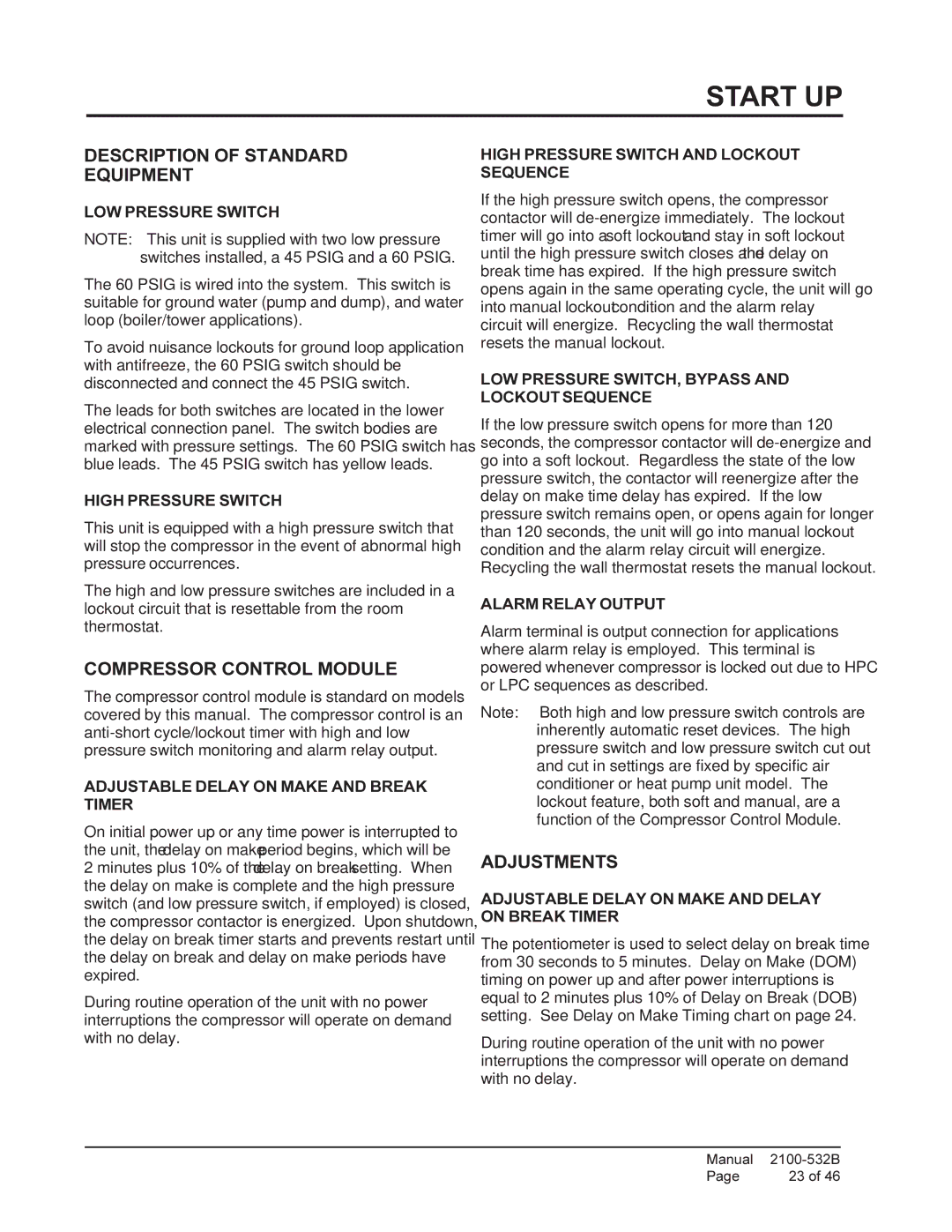
START UP
DESCRIPTION OF STANDARD
EQUIPMENT
LOW PRESSURE SWITCH
NOTE: This unit is supplied with two low pressure switches installed, a 45 PSIG and a 60 PSIG.
The 60 PSIG is wired into the system. This switch is suitable for ground water (pump and dump), and water loop (boiler/tower applications).
To avoid nuisance lockouts for ground loop application with antifreeze, the 60 PSIG switch should be disconnected and connect the 45 PSIG switch.
The leads for both switches are located in the lower electrical connection panel. The switch bodies are marked with pressure settings. The 60 PSIG switch has blue leads. The 45 PSIG switch has yellow leads.
HIGH PRESSURE SWITCH
This unit is equipped with a high pressure switch that will stop the compressor in the event of abnormal high pressure occurrences.
The high and low pressure switches are included in a lockout circuit that is resettable from the room thermostat.
COMPRESSOR CONTROL MODULE
The compressor control module is standard on models covered by this manual. The compressor control is an
ADJUSTABLE DELAY ON MAKE AND BREAK TIMER
On initial power up or any time power is interrupted to the unit, the delay on make period begins, which will be 2 minutes plus 10% of the delay on break setting. When the delay on make is complete and the high pressure switch (and low pressure switch, if employed) is closed, the compressor contactor is energized. Upon shutdown, the delay on break timer starts and prevents restart until the delay on break and delay on make periods have expired.
During routine operation of the unit with no power interruptions the compressor will operate on demand with no delay.
HIGH PRESSURE SWITCH AND LOCKOUT SEQUENCE
If the high pressure switch opens, the compressor contactor will
LOW PRESSURE SWITCH, BYPASS AND LOCKOUT SEQUENCE
If the low pressure switch opens for more than 120 seconds, the compressor contactor will
ALARM RELAY OUTPUT
Alarm terminal is output connection for applications where alarm relay is employed. This terminal is powered whenever compressor is locked out due to HPC or LPC sequences as described.
Note: Both high and low pressure switch controls are inherently automatic reset devices. The high pressure switch and low pressure switch cut out and cut in settings are fixed by specific air conditioner or heat pump unit model. The lockout feature, both soft and manual, are a function of the Compressor Control Module.
ADJUSTMENTS
ADJUSTABLE DELAY ON MAKE AND DELAY ON BREAK TIMER
The potentiometer is used to select delay on break time from 30 seconds to 5 minutes. Delay on Make (DOM) timing on power up and after power interruptions is equal to 2 minutes plus 10% of Delay on Break (DOB) setting. See Delay on Make Timing chart on page 24.
During routine operation of the unit with no power interruptions the compressor will operate on demand with no delay.
Manual | |
Page | 23 of 46 |
